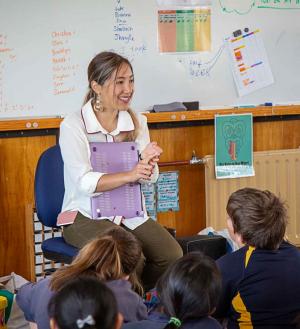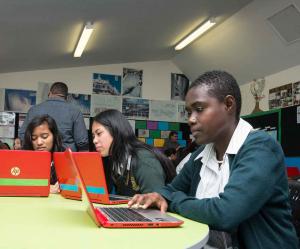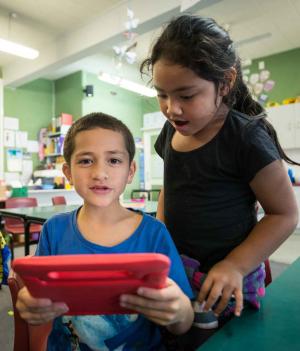Why this theme is important from an educational perspective

In business terms, process is a collection of related, structured activities or tasks that produce a specific outcome. Simply put, process may be understood as the way we do things. Important here is to understand that the way we do things will inevitably reflect our language, culture and identity, and the trends in this section must be considered through these lenses.
Educational institutions are historically very process-driven. Everything from enrolment to curriculum, to the approaches to teaching and learning, to how we capture data through assessment and how students pass through school to graduation, is process-driven. Each of these is characterised by the process that determines how things are done. Such processes provide order, create efficiency and ensure everything is done in a timely and consistent manner.
But, what if the conditions for which these processes were originally established have changed? Could our persistence with such processes actually inhibit our ability to change, or worse, negatively impact the outcomes we’re seeking to achieve for our clients - the learners?
It is becoming increasingly important that organisations examine their organisational processes and assess whether they remain fit for purpose or need to adapt to new conditions, especially as the environment is in a constant state of change.
Consider the following examples:
- Our management of how learners progress through their time in schools. For decades the primary approach taken here has been to allocate learners to classes based on age, and have them progress through the system, year by year, with their age-based cohort. The move towards more personalised learning approaches, the recognition that development in learning isn’t necessarily based on age and the benefits of whānau-based/multi-age groupings, are all reasons for considering alternatives to or adaptations of the current system.
- Our recording of and reporting on progress and achievement. This is a good example of where processes have been changing. Traditionally schools have been required to report on progress and achievement twice a year. This expectation has, for many, established internal processes associated with the timing of assessments to ensure that data is available for these reporting times. Many learning settings have taken advantage of the affordances of digital technologies to record, manage and share individual learner achievement. This has enabled, for some, the use of real-time reporting that provides up-to-date information to parents and caregivers and other teachers on a child’s progress, without having to wait for the twice yearly reports. But, even greater shifts are possible if we think about the movement of learners between learning centres and the need for this information to travel with them. Also, if we consider the need for this information to be in a form that is consistent with what is done in the new environment, so that support for learning can be provided in as seamless a way as possible.
- Our approach to funding learners and their learning. Our educational organisations are currently funded based on the number of children or young people they serve. This works well when these numbers are relatively stable and learners are doing all of their learning in that same environment. However, what if learners are hosted at a particular education setting where they are supported in some of their learning, but may also be enrolled in learning opportunities elsewhere (e.g. trades academies off-site or virtual classes provided by other organisations)? Our current processes of enrolling and then funding learners are actually inhibiting their opportunity to access and participate in the areas of learning they desire or require.
These are just some of the processes that we need to examine. As process-driven organisations, it is imperative that we are mindful of the need to constantly examine our ways of doing, being, and knowing. This will ensure we remain current as an organisation, and that we are succeeding in providing our children and young people with the best opportunities for learning that we can.
Summary of the patterns and trends over the past 15 years

Over the past 15 years the focus in our process theme for the Ten Trends has been largely on areas where technology is changing the game for organisations and educators. The overwhelming pattern in this theme has been the shift in terms of power and control in our education system. The shift to learner-centred approaches across all areas of our system has brought with it a shift in the ownership of learning. This has challenged and changed a number of the established processes to enable a greater degree of learner choice and control. This can be seen in three significant areas.
- Open-ness. The notion of open-ness as a process has significant implications for our education system, and more broadly, as by it we are effectively removing the middle person in many parts of our system (referred to as disintermediation in the technical literature). The concept of open-ness challenges and changes a wide range of the established processes we currently have in our system.
Early on we examined the impact of changes to the way we think about learning content, focusing on developments with user-generated content and open education resources. A key driver here has been the emergence of the World Wide Web (WWW), and with it, the breaking down of traditional understanding of who owns the information/knowledge - an idea that has underpinned the view of education as the transmission of knowledge (content) in the past. The WWW has changed the way we think and act in terms of content authoring, sharing and use. With that has come a challenge to the traditional views of copyright and the emergence of the Creative Commons community that recognises the authorship of the original creator, but allows for greater freedom in terms of distribution and use. The open education resources (OER) movement has emerged as a result of this thinking.
Open-ness in terms of resources is just the beginning. What has emerged since then is a broader view of how we are becoming more transparent across the whole of our system. Greater learner ownership and participation in this process means that we have had to open up many of the systems and processes that have been the domain of the educator or learning setting, and share these with the learners, and with their parents/family/whānau. - Data and learning. The second major pattern involves the impact of data on the ways places of learning and educators operate. In our trends over these years we have monitored the emergence of a data-driven smart web, and an increasing interest in data engagement by educators at all levels, particularly as we pursue an evidence-based approach to what we do. As digital technologies have enabled us to gather, store and manage increasingly large amounts of data, our approaches to how we gain value from this have evolved. This has led to a previously unknown field of learning analytics, and data-driven organisations. The more streamlined use of data has also underpinned much of what has been happening with assessment practices in schools, including real-time reporting and the emergence of micro-credentialing as a way of giving recognition to smaller, more timely learning achievements. We’ve also looked at the emergence of data science as a specialist field and explored the developments with artificial intelligence and machine learning, fed by huge amounts of data and providing customised insights that current human-based approaches can’t achieve in the same time-frame.
- Collaboration. Perhaps the biggest change in education settings that we’ve seen in recent years has been the emphasis given to collaborative practices, for teachers as well as learners. Underpinning this is the realisation that success in the future will more likely rely on the ability of humans to share their expertise and knowledge, and to actively work together to co-construct solutions to the complex issues that confront us. Evidence of collaboration as a key focus at a system level can be seen in our coverage of trends in other theme areas, including the emergence of Kāhui Ako and community engagement of early childhood centres, schools and kura.
Examples of impact and consequences

The shift in emphasis to a learner-centric approach across our whole education system is described more fully in the culture theme of our trends, but the evidence and impact of this shift is clearly seen in the process theme as well.
One of the most obvious areas in education where our processes are being challenged is the area of assessment. This includes the emergence of alternative forms of assessment, such as assessment for learning and narrative assessment, as we think about new ways of formally acknowledging learning that has taken place, and the assessments that are used to validate this.
The concept of personalising assessment is central to a lot of this thinking. In her paper on 7 Approaches to Alternative Assessments, Denise Pope, a senior lecturer at the Stanford University Graduate School of Education, shares assessment practices that help schools more effectively support students on their journey towards deeper learning and mastery.
Micro-credentialing and digital badging are emerging as a growing trend in how we make this level of personalised assessment manageable, and more in the hands of the learner themselves. Historically our ability to have our learning recognised has depended on completing large chunks of learning that are determined and packaged up by the providers of that learning. Micro-credentialing returns the ownership to the learner, and allows them to map their own pathway through the things of interest to them, and to have it recognised in a transferrable way. The use of digital badging at Ormiston Junior College illustrates the value of digital badging that incorporates elements of gamification, while linking closely to best practice in learning. DigitalBadgeED is another New Zealand initiative designed to support and grow the use of digital badges in schools, organisations, and clubs.
The super abundance of data, and the ability of artificial intelligence (AI) to process this is driving a lot of decision making at all levels of our system. But, what about the small data that relies on the knowledge and judgements that are made by people on an instance by instance basis? Renowned Finnish academic Pasi Sahlberg provides insights on the big data/small data dilemma, describing how learning analytics, algorithms and big data are knocking on the doors of many places of learning, promising fast improvements and new solutions to wicked problems facing them today.

The focus on deep learning and the change in pedagogical practice to ensure this occurs is increasingly evident in many settings. Deep learning occurs when learners participate in experiences that build on their strengths and needs, where they create new knowledge using real-life problem solving, and contribute by using their talents, purpose and passion. An excellent example of this can be seen in a project undertaken by students at Arrowtown School. The project was featured recently at the global NPDL Symposium to illustrate what can be achieved when learners are given agency to pursue solutions to problems they have identified. This example also illustrates the changing role of the teacher in the process, and brings the community engagement principle to life at their school, as they considered ways to connect learning with students’ wider lives. They have used a local, meaningful context for learning, which has enabled the school to grow educationally powerful relationships with local business and whānau.
Collaborative practice is becoming the new norm and is occurring at all levels, including learners, teachers and leadership. The shift from learning as a largely individual pursuit to a more collaborative activity pervades all areas of our system. This is illustrated well in a curriculum conversation on TKI with Stuart Armistead, who explains how the collaboration with students led to the development of their graduate profile - “Stanley Avenue Learner”. He describes how this vision has become a filter for every decision made at the school, including the way in which digital technologies are being used.
In another example, Rob Stevenson and Mary Pretorius from Dominion Road School discuss developing collaborative, innovative practice and classroom spaces to enhance student agency and experience. They talk about converting existing spaces and combining classes, and the experience and benefits of the Coaching and mentoring scheme for bringing their whole team on board. Leadership support has enabled autonomy, to set their own direction and structure and lead change, and filtered down into other teams within the school.
A cross sector example of collaboration "building successful learning foundations" led to re-imagining a learner-centred curriculum, deeper understanding of competencies, capabilities and continuity of learning between Te Whāriki and the New Zealand Curriculum.
A third example can be seen in the experience of teachers at Linton Camp School. They found that when they took collective responsibility for the progress of all learners there was improved learning and achievement in Mathematics, which was the focus for their pilot, and in higher level thinking skills.
What might we see moving forward into the future?

The two primary drivers of change in education will likely see continuing change and development in terms of the processes that underpin so many parts of our system. Indeed, the system itself will be challenged to change!
The ongoing shift of ownership of learning, together with the impact of data-driven technological solutions, will provide the perfect storm in which we’ll see so many of the well established processes in our places of learning and system challenged and changed. Some of the areas we’re likely to see impacted in this way are:
- A maturing of the Kāhui Āko/clusters across the country, with increased emphasis on the benefits of collaboration within and between learning communities. This may occur to the point where they will operate interdependently and as powerful ecologies of learning.
- Changes to our approach to assessment, including greater use of micro-credentials and of tools and technologies that allow learners to manage and control their own 'record of learning', including e-portfolios, blockchain developments, and formative and narrative assessment.
- Schools becoming more intentionally inclusive, their changing practices that ensure no learner is marginalised or excluded as they seek to achieve success in their learning.
-
Consider
Some questions that may help guide your thinking and discussions within your educational setting at a strategic level are:
- Which of the trends and issues in this theme have already impacted on your practice as an educator and/or on the way your organisation gets things done?
- How is data being used in your learning setting to empower both learners and teachers, and to reduce the administrative workload for everyone? What could be done differently or better to achieve this?
- How is the learning journey of your children or young people managed at present? Who owns this and why? How is the evidence of learning collected and verified? What are some of the pathways learners can follow in this journey, and who decides those pathways?
- What evidence of design thinking and/or gamification exist in your setting? How is it used and for what purpose? Is it just another approach, or is it fundamentally changing some of the ways things are done in your organisation?
-
Resources
For those wanting to dig deeper into some of the key drivers in this area, some references worth checking out include:
From previous CORE Ten Trends
From CORE
- Changing roles: a collaborative practice impact story
- "If you don’t lead with small data, you’ll be led by Big Data"
- Our history matters to our learning
- Preparing the next generation for the algorithmic age
- Time to get real with reporting
- Real-time Reporting
- Digital badging at Ormiston Junior College
- New Pedagogies for Deep Learning
From Grow Waitaha
- Vision: Create a collective and future focused vision for teaching and learning
- Collaborative Approach to Teaching and Learning
From EDtalks
- If you don’t lead with small data, you’ll be led by Big Data
- Preparing the next generation for the algorithmic age
Other
- Shaping a Marautanga-ā-Kura with your Community - Te Kura o Tākaro
- Marau ā-kura - Ōmanaia School
- Communities of Learning - Kāhui Ako in action - Education Review Office (2017)
- New micro-credentials system a first for New Zealand
- Moving the Rock: Seven Levers We Can Press to Transform Education